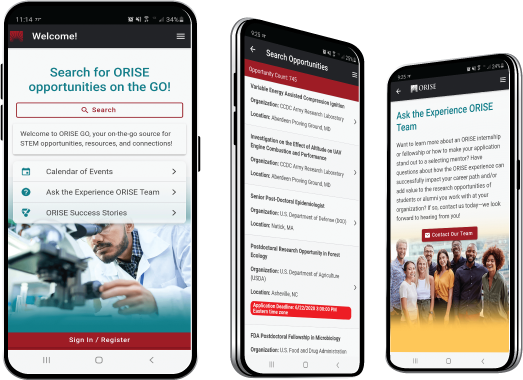Background reduction in high-efficiency measurement of beta-emitting fission products
Create and release your Profile on Zintellect – Postdoctoral applicants must create an account and complete a profile in the on-line application system. Please note: your resume/CV may not exceed 2 pages.
Complete your application – Enter the rest of the information required for the IC Postdoc Program Research Opportunity. The application itself contains detailed instructions for each one of these components: availability, citizenship, transcripts, dissertation abstract, publication and presentation plan, and information about your Research Advisor co-applicant.
Additional information about the IC Postdoctoral Research Fellowship Program is available on the program website located at: https://orau.org/icpostdoc/.
If you have questions, send an email to ICPostdoc@orau.org. Please include the reference code for this opportunity in your email.
Research Topic Description, including Problem Statement:
-
Improved measurement of anthropogenic radionuclides in the environment is needed to advance treaty monitoring capabilities and enable other national security applications.To obtain required measurements at trace levels, a complete analysis chain must include both a means to isolate the isotopes of interest and a method to measure them at levels typically below the levels present in naturally occurring materials. In the case of fission products that have weak or non-existent gamma-ray emission, the measurement of beta-decay particles could potentially satisfy these requirements.
-
Chemical separation is often employed to isolate groups and/or single elements for analysis of beta-activity. In trace-level measurements utilizing beta decay, the separation chemistry should efficiently segregate analyte isotopes to avoid interfering, cross-contaminating activity. For example, if a sample solution were to contain 1000 Bq of NORM isotopes (where NORM is naturally occurring radioactive materials)and 0.01 Bq ofmolybdenum-99 (99Mo), the separation chemistry must segregate 99Mo from NORM isotopes at a level of 1 part in 1,000,000 to ensure that NORM contribution to the measurement is not greater than 10% of the measurement of 99Mo. Exacerbating this problem for trace-level measurements is the fact that naturally occurring materials contain levels of radioactivity from NORM that will interfere with and overwhelm the measurement instrument relative to the measurement of the target isotope. The challenge is to develop a separations chemistry approach that is highly specific to the target isotope (providing required analyte selectivity) and is of high purity relative to introduction of unwanted background radioactivity from naturally occurring materials requiring process blank purity.
-
Incorporation of the beta-particle-emitting sample into a detection medium (e.g., a liquid or gas) should provide a high-efficiency method for measuring radioactive decays in the separated sample with near 100% efficiency. However, radiation measurements are only sensitive to radioactivity at levels not overwhelmed by the typical background rate (measurement blank) of the instrument. For example, commercial liquid scintillation counters typically achieve background count rates on the order of 1 count per minute. For trace-level measurements, the activity in the sample may only amount to 10-100 decays per day placing a premium on combining high efficiency for detection and minimizing the contribution of unwanted backgrounds.
-
The desired research should seek to advance the ‘state of the practice’ and further research to develop a complete analysis chain that can 1) measure trace levels of beta-emitting fission products at levels 10-100 times lower than readily available through commercially available techniques and 2) is applicable to the kinds of environmental samples likely to be used in treaty monitoring and national security applications. The research may consider sample preparation methods for producing low activity process blanks as well as the methods and instrumentation designed to minimize unwanted background rates for environmental or naturally occurring sources.
Example Approaches:
Experimental approaches, technical demonstrations on surrogate samples of interest, and an analysis trade study could be performed to answer the following:
-
What is the ultimate minimum detectable activity for a given chemical separation process as characterized by the process blank background rate? Does this support the goal of 10-100 times improved measurement levels for trace levels of beta-emitting fission products?
-
What modifications are required in the separation chemistry to reach the ultimate minimum detectable activity? What is the separations sequence for the studied beta-emitting fission products?
-
What radiation instrumentation designs can support the measurement of trace levels of radioactivity present in the samples prepared through the above process? What is the current best achievable performance?
-
What improvements in the radiation instrumentation would further enhance the sensitivity to trace levels of fission products? Are the improvements warranted given the status of the development level of the chemical separations process?
- What are the trades between the various approaches and are there figures of merit that can be used to predict performance on real-world samples vice ideal laboratory samples?
Postdoc Eligibility
- U.S. citizens only
- Ph.D. in a relevant field must be completed before beginning the appointment and within five years of the application deadline
- Proposal must be associated with an accredited U.S. university, college, or U.S. government laboratory
- Eligible candidates may only receive one award from the IC Postdoctoral Research Fellowship Program.
Research Advisor Eligibility
- Must be an employee of an accredited U.S. university, college or U.S. government laboratory
- Are not required to be U.S. citizens
- Citizenship: U.S. Citizen Only
- Degree: Doctoral Degree.
-
Discipline(s):
- Chemistry and Materials Sciences (12 )
- Communications and Graphics Design (6 )
- Computer, Information, and Data Sciences (16 )
- Earth and Geosciences (21 )
- Engineering (27 )
- Environmental and Marine Sciences (14 )
- Life Health and Medical Sciences (45 )
- Mathematics and Statistics (10 )
- Other Non-Science & Engineering (5 )
- Physics (16 )
- Science & Engineering-related (1 )
- Social and Behavioral Sciences (28 )

 ORISE GO
ORISE GO

The ORISE GO mobile app helps you stay engaged, connected and informed during your ORISE experience – from application, to offer, through your appointment and even as an ORISE alum!





